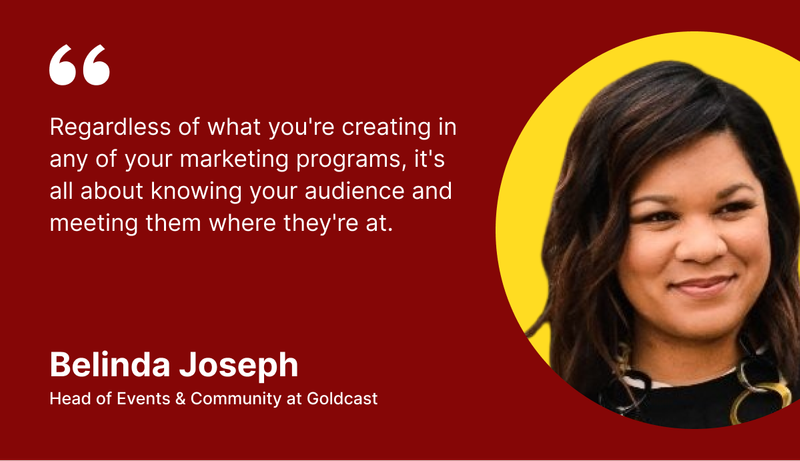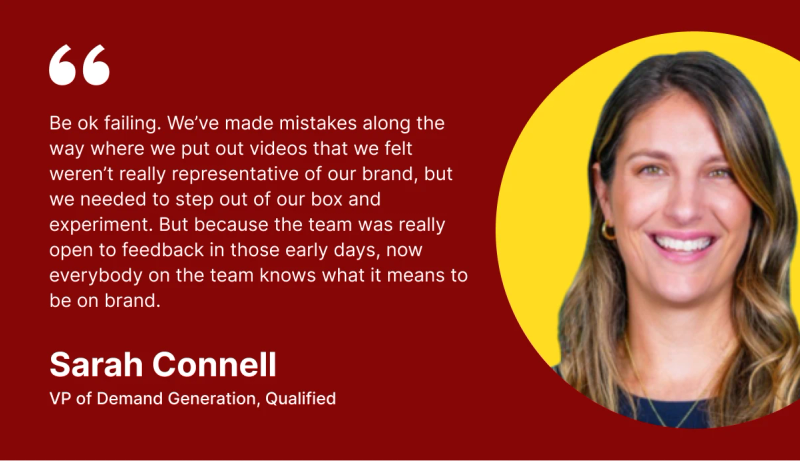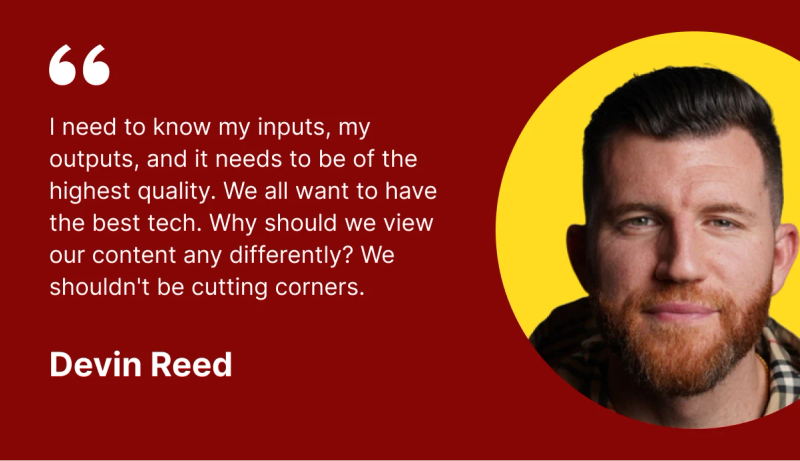How To Repurpose Video Content In 2024: Tips & Strategies
Table of Contents
Maximize Your Marketing ROI
Join 10,000 other marketers already getting the best tips on running engaging events that boost pipeline and create raving fans.
A decade ago, your average executive probably wouldn't have been caught scrolling social media during their buying process.
But that was then. Today, 75% of B2B buyers use social media to make buying decisions, which means your video content is a major part of their decision making process. Or at least, it can be.
In the 2020s, video marketing gets a lot of hype. And for good reason. But anyone who's ever tried it will tell you: consistently producing high-quality video content is a lot harder than it looks.
If you want to get every last drop of hard-earned ROI out of your video assets, you’re in the right place.
In this guide, we’ll share proven tips for repurposing long-form videos to maximize your impact across channels, plus steps to create a repurposing process that consistently delivers fresh video content—even on a tight budget or schedule.
What is video content repurposing?
Video content repurposing is the strategic practice of taking an existing piece of video content and reworking it to suit different channels to create an immersive experience for your audience.
For example, say you have an engaging video tutorial on YouTube. You can take that same tutorial and turn it into 1 to 2-minute “hot tip” video clips for social media. Not only does this provide instant value to your audience, it also multiplies the ways customers can interact with your brand, all while saving you precious time and resources.
And in an age where marketers are expected to do more with less, that’s nothing to sneeze at. At Goldcast, we’ve seen marketing teams save an average of two hours per video clip just by using a well-oiled repurposing process.
We’ll share more on how to do that later. But first, let’s take a closer look at how you can take one video and transform into dozens more.
Not just YouTube videos: 3 core pillars for repurposing video content
With video repurposing, you’re not just turning lemons into lemonade. You’re turning that same lemon into a refreshing lemon sorbet, tangy lemon cake, or a twist of snackable content.
“There's just such a wide breadth of video content that you can be utilizing as a company,” said Sarah Connell, VP of Demand Generation at Qualified in a recent episode of Coffee Corner. “As consumers, we're so used to video content on every platform that we're on. From LinkedIn to TikTok, it's all video first now.”
And therein lies the challenge. With 86% of marketing professionals using video as a marketing tool, it can be hard to keep up. So instead of creating brand new content for every medium, why not transform the videos you already have?
Here are just some of the ways to give new life to your existing videos.
1. Social media snippets
One of the most obvious and impactful ways to repurpose your video content is to deliver short, easily digestible short-form videos — a.k.a., snackable content — via social media posts.
This could include:
- Instagram reels
- LinkedIn carousel
- TikToks
- YouTube shorts
And with the latest introduction of features like the LinkedIn video tab, there’s likely much more to come.
When it comes to the types of videos you share on social, the sky’s the limit. Consider spotlighting your employees, sharing behind the scenes moments, or launching a trends-prediction series featuring an industry thought leader.
2. Product marketing
In a live poll at our recent Coffee Corner event, the majority of B2B marketers in attendance are currently using video content for product demos and launch announcements.
And those are both great places to start. But there are plenty of other ways to use video to level up your product marketing, including:
- Product how-tos
- Masterclasses
- Feature reels
- Case studies
Experts like Sarah are big believers in the power of video for answering key product questions, both for potential and existing customers.
“I think the how-to videos for product education are vastly different even from product demos because customers are looking for tactical help like, ‘I use your product, how can I be better at this? What am I missing in your product? How can I make the most out of what I'm paying for?’” says Sarah.
3. Sales follow-ups
“It's really important that your sales team know where your customers live and what kind of content they're typically consuming,” says Ernest Owusu.
Ernest is a big fan of video content. And as the Senior Director of Sales Development at 6Sense, he keeps his sales hat on at all times.
He’s not alone. A whopping 92% of marketers say they're seeing ROI on video, including increased sales, brand awareness and customer loyalty.
Here are a few tips to help you put video to work in your sales and account-based marketing workflows:
- Create personalized video messages for specific target accounts
- Showcase product demonstrations tailored to the needs of key decision-makers
- Share customer testimonial videos to build social proof and credibility
- Integrate video ads into targeted campaigns
With the right approach, video can help you grab the attention of key stakeholders within your target accounts and make a more human, personalized connection with high-value prospects.
“When we push out really good video content, our team actually looks to see the engagement within that and we piggyback off of that to drive conversations. We also know that if we're in an active deal and we're seeing that certain prospects are engaging with our videos, not only does it help us multithread better, it also kind of pushes the conversation in times where the deal is slower,” says Ernest.
[Looking for more ways to maximize your video content? Don’t miss these 11 powerful ways to get more out of every asset.]
How to create a repeatable video content repurposing process
From blog posts and infographics to podcast episodes and Instagram stories, there’s no limit to the ways you can repurpose your video content.
Once you have an idea of which formats work best for your audience, it’s time to develop an actionable strategy for getting maximum value out of every asset. Here’s the step-by-step for creating a video content repurposing process to fuel your multichannel strategy.
1. Narrow down your target audience
Just because the majority of B2B audiences are on LinkedIn, doesn’t mean they all are.
Before you start investing hours into your video content repurposing strategy, take time to find out exactly how and where your ideal customer profile (ICP) likes to consume video content.
Key questions to ask include:
- Who is our ideal viewer?
- What platforms do they frequent?
- What is the core messaging of our video?
Once you know how and where to position your video content, you can narrow your focus on the topics and formats most likely to resonate, and test until you discover what works.
“Regardless of what you're creating in any of your marketing programs, it's all about knowing your audience and meeting them where they're at,” says Belinda Joseph, Head of Events & Community at Goldcast.
2. Choose the right formats for the right platforms
Now here’s where the rubber meets the road. To maximize the full life cycle of every video, you need a plan for how you’ll get the initial source video and where it’s going to go once it’s been repurposed.
At this part of the process, it’s important to think about:
- What type of content do you want to get out of this?
- Where is this content going to be posted and distributed?
- What different platforms will you use?
- What different formats will you need?
- Do you need 16x9 for YouTube for website content?
- Do you need vertical 9x16s for YouTube shorts, LinkedIn, and TikTok?
Your answers to these questions will determine how you film (vertically or horizontally), which snippets you’ll need, where to embed your hooks and more.

3. Deliver the right information for the right formats
Just because you have the tools to chop a video up into smaller clips, doesn’t automatically mean those clips will perform well on other platforms.
Remember, the idea isn’t to water down your long-form video. With every repurposed clip, the goal is to add new value by giving your audience a more interesting or entertaining way to engage.
Here are some questions to consider:
- What core topics will you cover in the video?
- Which relevant sub-topics could be used for micro video content?
- Are you leading with a clear hook?
- Do you have the images you need to create an eye-catching thumbnail?
- Will you need live captions and/or translations?
To keep things ultra streamlined, consider the title and main topic of your long-form raw video before going into it. This will help make sure you’re ready and able to generate the best possible clips for other channels.
Once your multichannel video content is up and running, you can tap into your analytics to find out which content is working well with which target audiences, the top platforms they engage with, and more, in order to start refining your approach.
4. Decide who does what
Behind every high-octane content machine is a powerful team of marketers.
You need someone to create, edit, curate, publish and distribute your video content. If it sounds like a lot, that’s because it is.
But don’t worry. You don’t need a massive team (and equally massive budget) to consistently create and repurpose great video content.
You just need to assign the following tasks to the right folks in your team:
- Create - Even if you don’t have a videographer on your roster, someone needs to own the actual filming of the content. No matter who you choose, make sure this person has an eye for high-quality production.
- Curate - Review the clips and decide which clips to pull and what the hooks will be. This often involves moving things around, trimming and replacing clips until you get the snippets you need.
- Edit - Ask any pro videographer and they’ll tell you: post-production is where the magic happens. Make sure you have a real pro here, someone who not only knows what great video content looks like but also how to craft it.
- Write - As you near the finish line, you’re going to need someone (preferably someone with some knowledge of prompt engineering) to quickly generate the right copy for sharing the clip on social media, in your email marketing, blog, follow-ups, etc.
- Publish - Make sure you have someone owning the distribution of each clip to ensure all the pieces come together perfectly for a high-impact result.
Last but not least, you need to make sure the whole team knows what a quality end result looks like. That’s where a strong set of brand guidelines can help.
“The more video content you're doing and the faster you’re doing it, creating brand guidelines could be worth the exercise. It might feel kind of stale and old to make brand guidelines, but I will say we reference them all the time,” says Sarah. “Everyone across the marketing team knows what it means to be on-brand for us.”

5. Use AI to make your life easier
When Devin Reed set out to repurpose his event content into videos for social media, he was immediately hit with a laundry list of time-consuming tasks.
“It's like, hold on. I need to timestamp it to find the highlights. Then once we get the timestamps, I need to send it over to an editor. The editor was sick for a week. Okay. In a week or two, I'll get you it. And by the way, I need to pay $500 to $1,500 to get it done,’” says the Head of Content at Clari.
The truth is, no one can post high-quality video content consistently without the help of a strong process. And in 2024, that means automating and streamlining your process as much as you possibly can.
Here’s how the right AI and automation tools can help speed up the process:
- Auto-generate multiple short clips from one long-form asset
- Use AI to quickly navigate to the best moments in your long-form video
- Automatically remove ‘ums’, ‘ahs’, and other filler words
- Automatically add hooks, overlays, bumpers and CTAs
- Scheduling tool to distribute content on multiple platforms at one time
“I want as few people on the assembly line as possible with as few steps as possible with the best output,” explains Devin. He uses Content Lab to automatically generate snackable content clips from his event recordings, without the hassle of waiting days or weeks to hear back from an external video editing team.
“We can get this done in an afternoon versus a couple weeks,” he says.

Video repurposing made easy, with Goldcast
Video content is an investment, especially when it has high production value. Don’t that investment go to waste by cutting corners on your repurposing process.
Digital events like webinars, virtual summits, customer events, and more, can be a massive source of untapped video content just waiting to be repurposed—they’re relevant, engaging, and led by subject matter experts with insights you can’t get anywhere else.
The only question is, how can you extract that value into multiple shorter clips without spending time or money you don’t have?
To generate more video content in less time, Goldcast’s new repurposing tool, Content Lab, is here to help.
Content Lab makes it easy to:
- Find the best moments quickly. Just highlight the moment you want to clip, click Create Clip and your top clips will automatically appear in the side panel.
- Dive deeper on a specific topic. Autogenerate long-form clips to offer deeper insights, without the endless rewatching and manual time stamping.
- Create a high-quality content assembly line. Expert marketers like Sarah and Devin are already using Content Lab to create better content in a fraction of the time.
“We use Goldcast for our events and our content marketer finds it so incredibly valuable because she can take a large event that's three hours and cut it up into small pieces for other channels,” says Sarah.
Of course, there’s no point repurposing content that doesn’t have high-quality production value in the first place.
In addition to Content Lab, marketers who use Goldcast also gain access to:
- Professional grade video production built right into the platform
- A large suite of engagement tools to keep your event footage interactive
- Customizable On-Demand hub to extend the impact of your video content long after the event
- Automatic translations, subtitles and captioning to make event videos accessible to a wider audience
- Deep analytics to help inform which parts of the event footage to repurpose to which platform(s)
Whether you use Goldcast or another platform, don’t overlook the power of your event content as a treasure trove of high quality videos to fuel your multichannel strategy.
Goldcast Content Lab: built for purpose
Whether your goal is to elevate your long-term video marketing strategy or fuel your sales-driven nurture or ABM program, success video content repurposing starts before you hit the little red button.
And if you’re running events, you’re already a step ahead.
Content Lab can help fast-track your video repurposing process to help you create engaging video, blog and social content in a fraction of the time.
Sign up for a free trial and learn how Content Lab can give you more video in less time. Or book a demo of Goldcast to see the full platform in action.
Transform Your Video Marketing with AI
Stay In Touch
Platform
Resources
© 2025 Copyright Goldcast, Inc. All rights reserved.





 Upcoming Events
Upcoming Events Event Series
Event Series On-Demand Events
On-Demand Events

